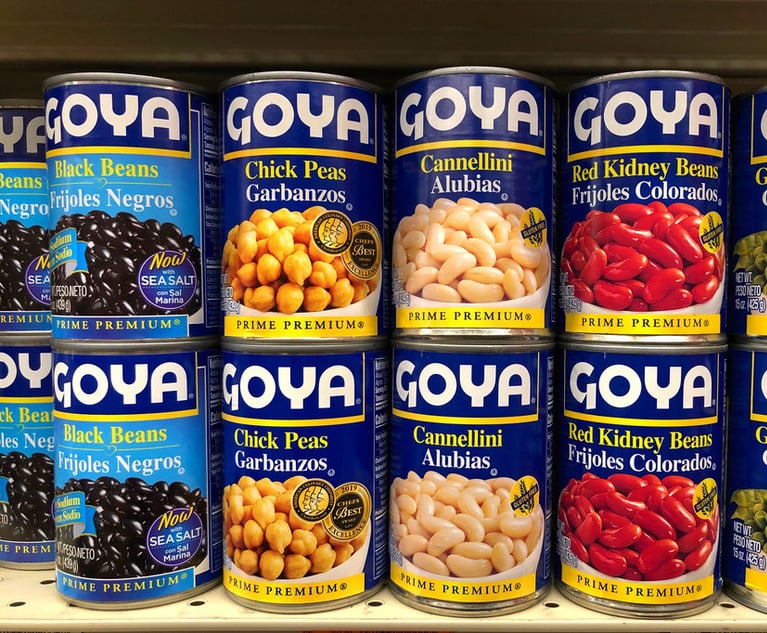IP: Piggybacking design patents and trademark rights
What do the Coca Cola Bottle, Ring Pop candy and the PedEgg foot micro file all have in common?
July 23, 2013 at 05:15 AM
4 minute read
The original version of this story was published on Law.com
What do the Coca Cola Bottle, Ring Pop candy and the PedEgg foot micro file all have in common? The designs of each were once, or still are, protected by design patents in the U.S. and are also well-known trademarks. Why would a company use two forms of intellectual property protection to protect the same thing? Piggybacking design patent and trademark rights is a clever strategy to obtain strong intellectual property protection for a three-dimensional brand.
Trademark rights exist in nearly anything capable of being represented graphically, and which functions as an identifier of source. This definition includes typical word marks, logos and taglines used with products and services. It is also broad enough to include the shape and appearance of the product itself. Shape and appearance, as well as the way a product is packaged, are often referred to as “trade dress.” Trade dress, like a service or certification mark, is a type of trademark right.
Unfortunately, it can be difficult to register product design trade dress with the U.S. Patent and Trademark Office (PTO) until the trade dress has acquired secondary meaning. Or, in other words, until the product design trade dress serves as an identifier of the source of the product, as all trademarks must, in the eyes of consumers. In some cases, it may take several years and significant advertising of the design before a company can show that the design is functioning as a source identifier and therefore, that it has secondary meaning. How then does a company protect its product design while it is establishing trademark rights?
One approach is to obtain design patent protection for the product design. Design patents are available for any ornamental product design that is novel, not obvious and not functional. No use or consumer recognition of the design is required to obtain or maintain a design patent in the U.S. Unlike utility patents, the PTO grants design patents fairly quickly—in about 12 months from filing and they last for 14 years from their issue date. In some circumstances, a design patent can be obtained in a matter of months.
Design patents are also presumed valid immediately after grant, while trademarks only become incontestable after at least 5 years of continuous use. The test for infringement of a design patent is “substantial similarity” between the patented design and the accused infringing design. There is no requirement to show consumer confusion or a likelihood of consumer confusion through costly consumer surveys, as is often necessary with trademarks. Perhaps what is most attractive about design patents is that the typical measure of damages for infringement is disgorgement of the infringer's total profit. No actual loss to the patent holder is required to obtain money damages from an infringer.
The challenge with design patent protection, however, is that the product design should not be disclosed to the public before the design patent application is filed. The reason for this is that prior disclosure may prevent companies from obtaining a valid patent in the U.S and abroad. This is particularly challenging when it is necessary or desirable to do consumer testing before putting a new product on the market. An invalidating disclosure can be avoided by having proper confidentially agreements in place. Nevertheless, because of this challenge, it is important that care be taken before a new product is launched to create a strategy that will protect the product design throughout its lifecycle.
When used together, design patents and trade dress protection can be a synergistic pairing to ensure that unique and valuable product designs are protected, even before a product is launched.
This content has been archived. It is available through our partners, LexisNexis® and Bloomberg Law.
To view this content, please continue to their sites.
Not a Lexis Subscriber?
Subscribe Now
Not a Bloomberg Law Subscriber?
Subscribe Now
NOT FOR REPRINT
© 2025 ALM Global, LLC, All Rights Reserved. Request academic re-use from www.copyright.com. All other uses, submit a request to [email protected]. For more information visit Asset & Logo Licensing.
You Might Like
View All
Best Practices for Adopting and Adapting to AI: Mitigating Risk in Light of Increasing Regulatory and Shareholder Scrutiny
7 minute read
FOMO Run Amok? Resolve of Firms Chasing AI Dreams Tested by Sky-High Costs


Trending Stories
- 1The Appropriate Exemption in Students for Fair Admissions v. President & Fellows of Harvard College
- 2DOJ, 10 State AGs File Amended Antitrust Complaint Against RealPage and Big Landlords
- 3New Partners at Cummings & Lockwood, Carmody Torrance Sandak & Hennessey
- 4'Extra Government'?: NY Top Court Eyes Ethics Commission's Constitutionality
- 5South Texas College of Law Houston Selects New Dean
Who Got The Work
Michael G. Bongiorno, Andrew Scott Dulberg and Elizabeth E. Driscoll from Wilmer Cutler Pickering Hale and Dorr have stepped in to represent Symbotic Inc., an A.I.-enabled technology platform that focuses on increasing supply chain efficiency, and other defendants in a pending shareholder derivative lawsuit. The case, filed Oct. 2 in Massachusetts District Court by the Brown Law Firm on behalf of Stephen Austen, accuses certain officers and directors of misleading investors in regard to Symbotic's potential for margin growth by failing to disclose that the company was not equipped to timely deploy its systems or manage expenses through project delays. The case, assigned to U.S. District Judge Nathaniel M. Gorton, is 1:24-cv-12522, Austen v. Cohen et al.
Who Got The Work
Edmund Polubinski and Marie Killmond of Davis Polk & Wardwell have entered appearances for data platform software development company MongoDB and other defendants in a pending shareholder derivative lawsuit. The action, filed Oct. 7 in New York Southern District Court by the Brown Law Firm, accuses the company's directors and/or officers of falsely expressing confidence in the company’s restructuring of its sales incentive plan and downplaying the severity of decreases in its upfront commitments. The case is 1:24-cv-07594, Roy v. Ittycheria et al.
Who Got The Work
Amy O. Bruchs and Kurt F. Ellison of Michael Best & Friedrich have entered appearances for Epic Systems Corp. in a pending employment discrimination lawsuit. The suit was filed Sept. 7 in Wisconsin Western District Court by Levine Eisberner LLC and Siri & Glimstad on behalf of a project manager who claims that he was wrongfully terminated after applying for a religious exemption to the defendant's COVID-19 vaccine mandate. The case, assigned to U.S. Magistrate Judge Anita Marie Boor, is 3:24-cv-00630, Secker, Nathan v. Epic Systems Corporation.
Who Got The Work
David X. Sullivan, Thomas J. Finn and Gregory A. Hall from McCarter & English have entered appearances for Sunrun Installation Services in a pending civil rights lawsuit. The complaint was filed Sept. 4 in Connecticut District Court by attorney Robert M. Berke on behalf of former employee George Edward Steins, who was arrested and charged with employing an unregistered home improvement salesperson. The complaint alleges that had Sunrun informed the Connecticut Department of Consumer Protection that the plaintiff's employment had ended in 2017 and that he no longer held Sunrun's home improvement contractor license, he would not have been hit with charges, which were dismissed in May 2024. The case, assigned to U.S. District Judge Jeffrey A. Meyer, is 3:24-cv-01423, Steins v. Sunrun, Inc. et al.
Who Got The Work
Greenberg Traurig shareholder Joshua L. Raskin has entered an appearance for boohoo.com UK Ltd. in a pending patent infringement lawsuit. The suit, filed Sept. 3 in Texas Eastern District Court by Rozier Hardt McDonough on behalf of Alto Dynamics, asserts five patents related to an online shopping platform. The case, assigned to U.S. District Judge Rodney Gilstrap, is 2:24-cv-00719, Alto Dynamics, LLC v. boohoo.com UK Limited.
Featured Firms
Law Offices of Gary Martin Hays & Associates, P.C.
(470) 294-1674
Law Offices of Mark E. Salomone
(857) 444-6468
Smith & Hassler
(713) 739-1250






